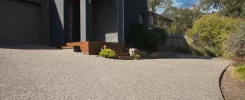Are you planning new driveway, patio? Or maybe cover that slippery area around the pool?
If you are not sure how to do this, here are the top five most popular options for concrete paved driveway, each with its own characteristics in terms of durability, aesthetics, and maintenance.
Each of these concrete paving options offers unique benefits, allowing homeowners to choose one that fits their style, budget, and functional needs.
Stamped Concrete Driveway
Stamped concrete can mimic high-end materials like stone, brick, or even wood while using durable concrete. It’s created by pressing patterns into the wet concrete before it cures, offering a decorative look without high costs. Various colors and patterns are available, allowing for a custom look that suits any home style.
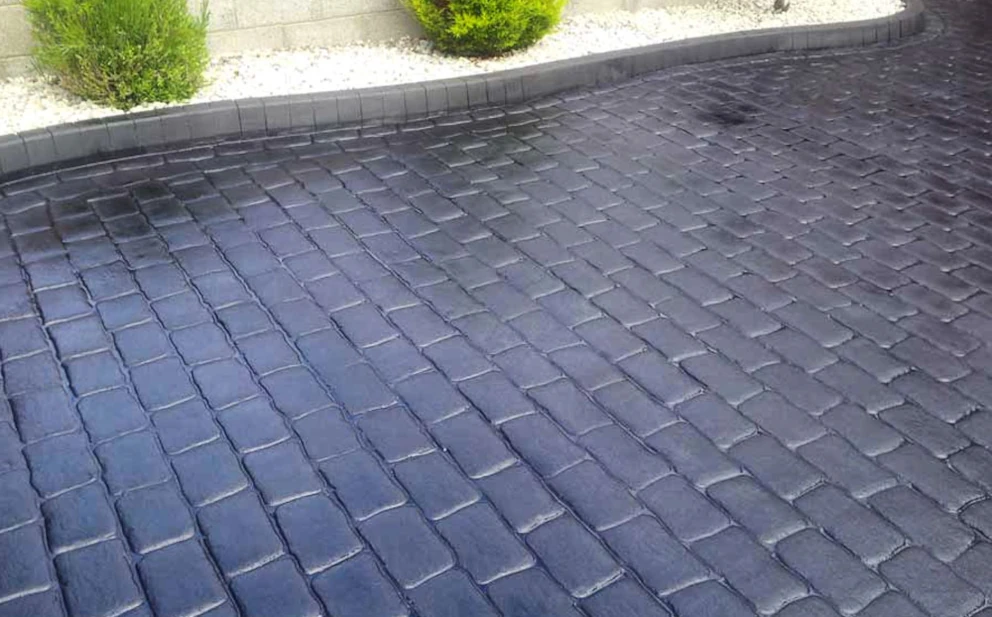
• Aesthetic Appeal: Stamped concrete can replicate the look of high-end materials like brick, slate, or cobblestone at a fraction of the cost, allowing for a custom, decorative concrete paved driveway look. The stamping patterns and color options are versatile, making it suitable for various home designs. You can choose from various patterns, textures and colors to achieve the desired look. Popular patterns include cobblestone, brick, slate and tile.
• Durability: This concrete driveway type is durable but may be more prone to cracking in extreme climates. However, applying a protective sealer every few years can extend its lifespan. Proper sealing can protect stamped concrete area from stains, moisture and different chemicals.
• Maintenance: Regular maintenance includes resealing every 2–3 years to prevent color fading and protect against stains and wear. Occasional pressure cleaning can help keep it in good condition. With proper maintenance, a stamped concrete driveway can last for decades, making it a good long-term investment.
• Cost: Stamped concrete is more expensive than plain concrete but generally less costly than real stone or brick paving. The look and appeal often justify the added cost.
Exposed Aggregate Concrete Driveway
This style features a textured, pebbled look that enhances grip and adds visual interest. By exposing the aggregate (stones or pebbles) within the concrete, it creates a durable, slip-resistant surface that is low maintenance and resistant to cracking. The exposed aggregate process involves pouring concrete and then exposing the top layer of stones.
• Aesthetic Appeal: The exposed aggregate finish adds visual texture with natural stone or pebbles embedded in the concrete, giving it a unique look and feel. This style works well for modern and rustic home exteriors and can add character and a natural aesthetic to outdoor areas.
The exposed aggregate process involves pouring concrete and then exposing the top layer of stones.
This is usually done by:
• Seeding the Surface: Additional aggregate is sprinkled on top before the concrete sets to enhance color or texture.
• Water Washing: The top layer of concrete is washed off using water to expose the aggregate.
• Retarder Spray: A surface retarder is sometimes applied to slow down the curing of the top layer, making it easier to wash off later.
• Durability: Exposed aggregate driveways are highly durable, with stones or pebbles providing additional surface resilience. The texture also improves grip, which is helpful in wet conditions. Exposed aggregate is highly durable and resistant to heavy foot and vehicle traffic. It’s also more resistant to extreme weather conditions compared to some other finishes.
• Maintenance: Requires periodic washing and resealing every few years to prevent stone loosening and protect against stains.
Maintenance Tips of Exposed Aggregate Concrete Driveway
- Sealing: Sealing every 2-3 years will protect the aggregate, enhancing its color and protecting it from water and chemical damage.
- Cleaning: Power washing is a good way to keep it clean, as the textured surface can trap dirt and debris.
- Repair: In case of cracks or worn areas, patching or resealing can help maintain its appearance.
Brushed Concrete Driveway
Brushed or broom-finished concrete is created by brushing the surface while it’s still wet, giving it a slip-resistant texture. This style is affordable, functional, and provides a clean, modern look with a reliable non-slip surface. While simpler in appearance, it’s highly durable and requires little maintenance.
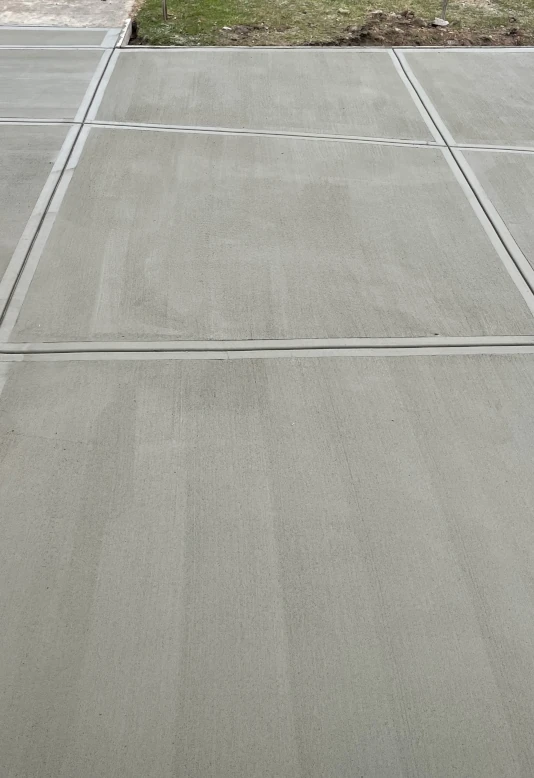
• Aesthetic Appeal: Brushed (or broom-finished) concrete paved driveway has a subtle, linear texture from a broom or brush dragged across the wet surface. It’s a clean, minimalist style that works well with various home exteriors but doesn’t provide the decorative flair of stamped or colored concrete. But it is popular and durable choice for residential driveways. It’s slip resistant, provides better grip making it safer in wet conditions. . This type of concrete driveway is often recommended by most City Councils and is used for footpaths and crossovers.
• Durability: Brushed concrete is one of the most durable options due to its simplicity and uniform texture. It holds up well in harsh climates and heavy traffic
• Maintenance: This type of driveway requires very little maintenance aside from occasional cleaning. Adding a sealer will enhance its durability but isn’t necessary.
• Cost: Typically, this is the most budget-friendly option, making it popular for homeowners looking for practicality over aesthetics.
Colored Concrete Driveway
Adding pigment to concrete provides a vibrant or natural hue to complement home exteriors. Colored concrete can be paired with other finishes, like stamping, to achieve a custom look. This method is popular for those wanting a customized driveway with aesthetic appeal and longevity.
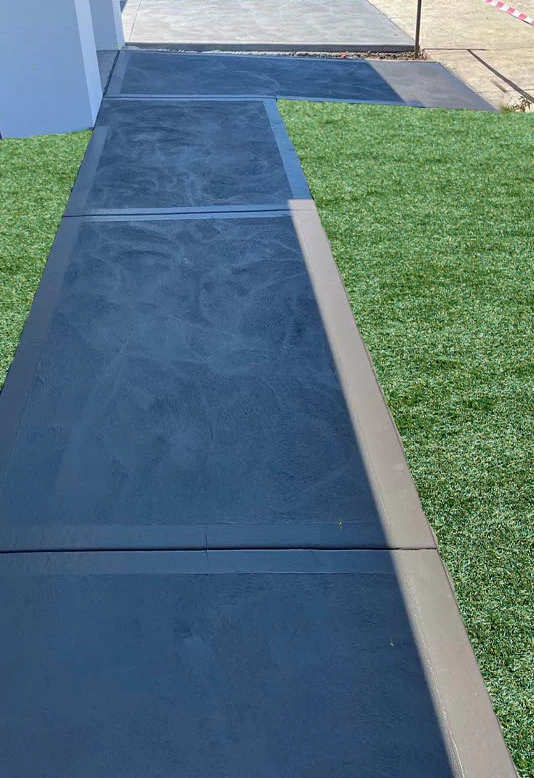
• Aesthetic Appeal: Colored concrete driveway adds a custom look and enhances the curb appeal of your home, providing a durable, long lasting and aesthetically pleasing surface Adding color to plain concrete allows homeowners to customize the driveway to match or contrast with their home. The color can be mixed in or applied to the surface, which enables options like a natural, earthy look or bold, vibrant tones.
• Durability: Colored concrete is as durable as regular concrete. However, the color can fade over time, especially in areas with high sun exposure.
• Maintenance: Resealing every 2–3 years helps preserve the color and protect against stains. For high-traffic areas, touch-up applications may be needed to prevent discoloration.
• Cost: Colored concrete is more expensive than plain concrete due to the added materials but is still relatively affordable compared to decorative stones.
• A colored concrete driveway combines functionality with creative design, adding value to your property and personalizing its exterior.
Permeable Concrete Driveway
Permeable (or porous) concrete has small gaps that allow water to pass through, making it environmentally friendly by reducing runoff. It’s an ideal option in areas with heavy rainfall or where eco-friendly solutions are prioritized. The look is more unique due to its coarse texture, and it provides good durability with proper maintenance.
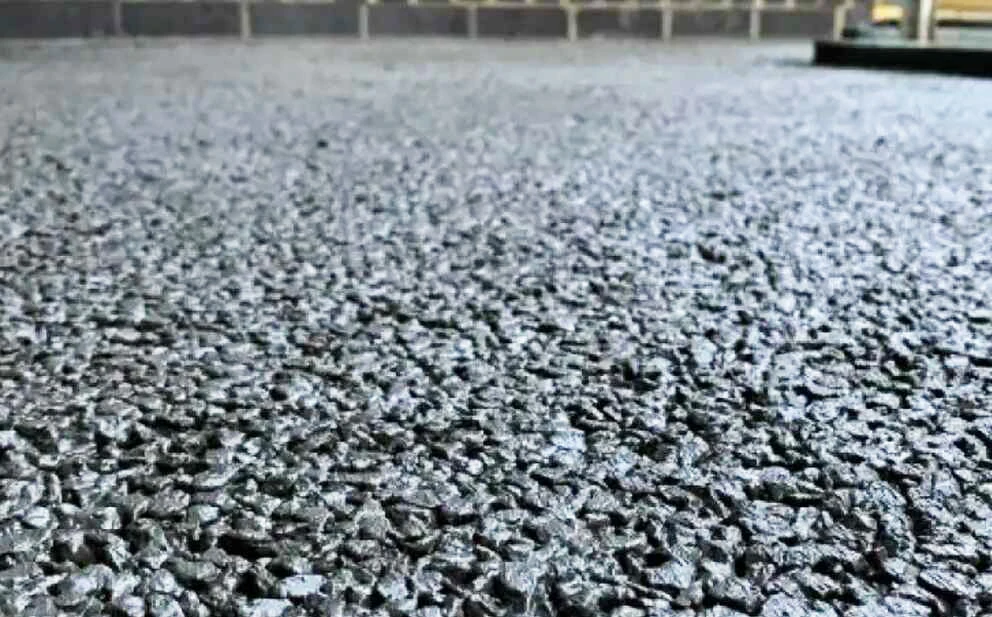
• Aesthetic Appeal: Permeable concrete has a coarse texture and a more porous look, which can suit contemporary or eco-friendly designs. It is a specialized type of concrete with a high porosity, allowing water to flow through it easily. This characteristic makes it ideal for managing storm water and reducing runoff, particularly in urban areas where less permeable surfaces like traditional concrete can lead to flooding and water quality issue. It’s less common in residential areas but gaining popularity for sustainable projects. The concrete mix contains little or no fine aggregates (like sand), which creates a network of voids that allow water to infiltrate. This permeability can reduce the need for stormwater management systems.
• Durability: Permeable concrete is designed to allow water drainage, which reduces erosion and helps prevent pooling. However, in cold climates, it can be more susceptible to freeze-thaw damage if not installed properly.
• Maintenance: Regular sweeping or vacuuming is required to prevent clogs in the porous structure. Occasional resealing will also help preserve its durability. Using a vacuum sweeper periodically helps remove dirt and organic material. Power washing can help prevent the buildup of debris in the void. Inspect regularly to ensure the material remains permeable, as clogging can reduce effectiveness.
• Cost: Permeable concrete is often pricier due to the additional steps in installation and the specialized materials, but it’s a great investment for eco-conscious homeowners, especially in rainy regions.
Why choosing the Right Concrete Driveway is important?
Choosing the right type of concrete driveway is essential because it directly affects the driveway’s durability, aesthetic appeal, and maintenance needs. Here are a few reasons why this decision matters:
Durability and Longevity
Different types of concrete can handle various levels of wear and tear. Driveways need to withstand heavy vehicles, weather changes, and frequent use. Opting for a high-quality concrete mix can prevent cracks, potholes, and erosion, giving your driveway a longer lifespan.
Aesthetic Appeal
The driveway is often the first part of a property people see, so selecting a style, texture, and color that complement your home enhances curb appeal. Decorative options, like stamped or colored concrete, offer customization options that can significantly elevate your driveway’s appearance.
Maintenance Needs
The type of concrete affects how often you’ll need to perform maintenance. For instance, stamped concrete requires regular resealing to maintain its appearance and prevent fading. Some surfaces are easier to clean or may resist staining better than others, making upkeep less intensive.
Cost-Effectiveness
Initial cost is a factor, but so are long-term costs related to repairs and maintenance. Choosing a durable and low-maintenance type of concrete can be more cost-effective over time, saving you money on frequent repairs or resurfacing.
Weather Resistance
In colder climates, where freeze-thaw cycles are common, certain types of concrete mixes with specific additives are better suited to handle these conditions. This reduces the likelihood of cracking, scaling, or other forms of deterioration.

